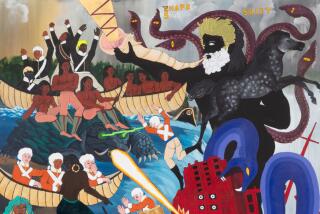Animal behavior
- Share via
Walton Ford figured out pretty early there are many ways to tell all manner of stories: adventure, just so and tall tales. Ford’s vibrant, big-as-life watercolors of animals -- bison, zebras, yellow-eyed wolves, red-tailed ducks -- are many things at once: stunning and startling, harrowing and humorous, political and poetic. Just out from Taschen, his book “Pancha Tantra” (the title taken from the ancient Indian book of animal fables from the 3rd to 5th centuries BC), provides the first comprehensive viewing of Ford’s work in all of its gory, hyper-real glory.
The paintings, in their fine technical precision, look as if they are the meticulous work of 19th century natural science illustrations or British colonial paintings (and the references to John James Audubon, who is evoked throughout, aren’t oblique), but something else is lurking. The layered stories -- the animals often caught mid-strike, wolves devouring their prey or monkeys upsetting a formal dining table -- are visual allegories. Ford uses the expanse of the paintings (many life-size) as examinations of how the environment has been endangered. Ford has been exhibited widely, including the Whitney, the Brooklyn Museum and at the Michael Cohn Gallery in Los Angeles. A native of Larchmont, N.Y., and graduate of the Rhode Island School of Design, he had intended to become a filmmaker. And in a way, the publication of the enormous “Pancha Tantra” -- with an abundance of gatefold pages that, once opened, make the creatures seem to lunge at you -- could be Ford’s book world stab at Cinerama.
-- Lynell George
More to Read
Sign up for our Book Club newsletter
Get the latest news, events and more from the Los Angeles Times Book Club, and help us get L.A. reading and talking.
You may occasionally receive promotional content from the Los Angeles Times.









